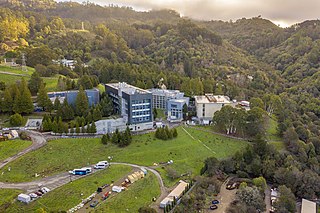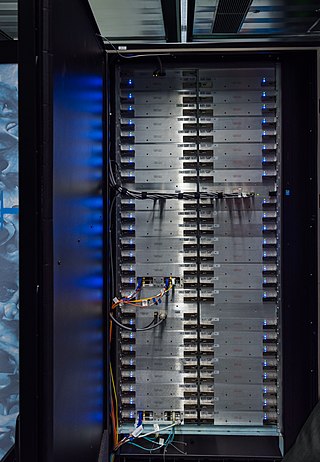Related Research Articles

A supercomputer is a type of computer with a high level of performance as compared to a general-purpose computer. The performance of a supercomputer is commonly measured in floating-point operations per second (FLOPS) instead of million instructions per second (MIPS). Since 2022, supercomputers have existed which can perform over 1018 FLOPS, so called exascale supercomputers. For comparison, a desktop computer has performance in the range of hundreds of gigaFLOPS (1011) to tens of teraFLOPS (1013). Since November 2017, all of the world's fastest 500 supercomputers run on Linux-based operating systems. Additional research is being conducted in the United States, the European Union, Taiwan, Japan, and China to build faster, more powerful and technologically superior exascale supercomputers.

Lawrence Berkeley National Laboratory is a federally funded research and development center in the hills of Berkeley, California, United States. Established in 1931 by the University of California (UC), the laboratory is sponsored by the United States Department of Energy and administered by the UC system. Ernest Lawrence, who won the Nobel prize for inventing the cyclotron, founded the lab and served as its director until his death in 1958. Located in the Berkeley Hills, the lab overlooks the campus of the University of California, Berkeley.
Floating point operations per second is a measure of computer performance in computing, useful in fields of scientific computations that require floating-point calculations.
Cray Inc., a subsidiary of Hewlett Packard Enterprise, is an American supercomputer manufacturer headquartered in Seattle, Washington. It also manufactures systems for data storage and analytics. Several Cray supercomputer systems are listed in the TOP500, which ranks the most powerful supercomputers in the world.

Saul Perlmutter is a U.S. astrophysicist, a professor of physics at the University of California, Berkeley, where he holds the Franklin W. and Karen Weber Dabby Chair, and head of the International Supernova Cosmology Project at the Lawrence Berkeley National Laboratory. He is a member of both the American Academy of Arts & Sciences and the American Philosophical Society, and was elected a Fellow of the American Association for the Advancement of Science in 2003. He is also a member of the National Academy of Sciences. Perlmutter shared the 2006 Shaw Prize in Astronomy, the 2011 Nobel Prize in Physics, and the 2015 Breakthrough Prize in Fundamental Physics with Brian P. Schmidt and Adam Riess for providing evidence that the expansion of the universe is accelerating. Since 2021, he has been a member of the President’s Council of Advisors on Science and Technology (PCAST).

The National Energy Research Scientific Computing Center (NERSC), is a high-performance computing (supercomputer) research facility that was founded in 1974. The National User Facility is operated by Lawrence Berkeley National Laboratory for the United States Department of Energy Office of Science.

William James Dally is an American computer scientist and educator. He is the chief scientist and senior vice president at Nvidia and was previously a professor of Electrical Engineering and Computer Science at Stanford University and MIT. Since 2021, he has been a member of the President's Council of Advisors on Science and Technology (PCAST).

The TOP500 project ranks and details the 500 most powerful non-distributed computer systems in the world. The project was started in 1993 and publishes an updated list of the supercomputers twice a year. The first of these updates always coincides with the International Supercomputing Conference in June, and the second is presented at the ACM/IEEE Supercomputing Conference in November. The project aims to provide a reliable basis for tracking and detecting trends in high-performance computing and bases rankings on HPL benchmarks, a portable implementation of the high-performance LINPACK benchmark written in Fortran for distributed-memory computers.
The National Center for Computational Sciences (NCCS) is a United States Department of Energy (DOE) Leadership Computing Facility that houses the Oak Ridge Leadership Computing Facility (OLCF), a DOE Office of Science User Facility charged with helping researchers solve challenging scientific problems of global interest with a combination of leading high-performance computing (HPC) resources and international expertise in scientific computing.

Arm Holdings plc is a British semiconductor and software design company based in Cambridge, England, whose primary business is the design of central processing unit (CPU) cores that implement the ARM architecture family of instruction sets. It also designs other chips, provides software development tools under the DS-5, RealView and Keil brands, and provides systems and platforms, system-on-a-chip (SoC) infrastructure and software. As a "holding" company, it also holds shares of other companies. Since 2016, it has been majority owned by Japanese conglomerate SoftBank Group.
This list compares various amounts of computing power in instructions per second organized by order of magnitude in FLOPS.

Several centers for supercomputing exist across Europe, and distributed access to them is coordinated by European initiatives to facilitate high-performance computing. One such initiative, the HPC Europa project, fits within the Distributed European Infrastructure for Supercomputing Applications (DEISA), which was formed in 2002 as a consortium of eleven supercomputing centers from seven European countries. Operating within the CORDIS framework, HPC Europa aims to provide access to supercomputers across Europe.

Titan or OLCF-3 was a supercomputer built by Cray at Oak Ridge National Laboratory for use in a variety of science projects. Titan was an upgrade of Jaguar, a previous supercomputer at Oak Ridge, that uses graphics processing units (GPUs) in addition to conventional central processing units (CPUs). Titan was the first such hybrid to perform over 10 petaFLOPS. The upgrade began in October 2011, commenced stability testing in October 2012 and it became available to researchers in early 2013. The initial cost of the upgrade was US$60 million, funded primarily by the United States Department of Energy.
The Cray XC30 is a massively parallel multiprocessor supercomputer manufactured by Cray. It consists of Intel Xeon processors, with optional Nvidia Tesla or Xeon Phi accelerators, connected together by Cray's proprietary "Aries" interconnect, stored in air-cooled or liquid-cooled cabinets. Each liquid-cooled cabinet can contain up to 48 blades, each with eight CPU sockets, and uses 90 kW of power. The XC series supercomputers are available with the Cray DataWarp applications I/O accelerator technology.

The Cray XC40 is a massively parallel multiprocessor supercomputer manufactured by Cray. It consists of Intel Haswell Xeon processors, with optional Nvidia Tesla or Intel Xeon Phi accelerators, connected together by Cray's proprietary "Aries" interconnect, stored in air-cooled or liquid-cooled cabinets. The XC series supercomputers are available with the Cray DataWarp applications I/O accelerator technology.

Summit or OLCF-4 is a supercomputer developed by IBM for use at Oak Ridge Leadership Computing Facility (OLCF), a facility at the Oak Ridge National Laboratory, United States of America. As of June 2024, it is the 9th fastest supercomputer in the world on the TOP500 list. It held the number 1 position on this list from November 2018 to June 2020. Its current LINPACK benchmark is clocked at 148.6 petaFLOPS.

Hewlett Packard Enterprise Frontier, or OLCF-5, is the world's first exascale supercomputer. It is hosted at the Oak Ridge Leadership Computing Facility (OLCF) in Tennessee, United States and became operational in 2022. As of November 2024, Frontier is the second fastest supercomputer in the world. It is based on the Cray EX and is the successor to Summit (OLCF-4). Frontier achieved an Rmax of 1.102 exaFLOPS, which is 1.102 quintillion floating-point operations per second, using AMD CPUs and GPUs.

Aurora is an exascale supercomputer that was sponsored by the United States Department of Energy (DOE) and designed by Intel and Cray for the Argonne National Laboratory. It was briefly the second fastest supercomputer in the world from November 2023 to June 2024.

SXM is a high bandwidth socket solution for connecting Nvidia Compute Accelerators to a system. Each generation of Nvidia Tesla since P100 models, the DGX computer series and the HGX boards come with an SXM socket type that realizes high bandwidth, power delivery and more for the matching GPU daughter cards. Nvidia offers these combinations as an end-user product e.g. in their models of the DGX system series. Current socket generations are SXM for Pascal based GPUs, SXM2 and SXM3 for Volta based GPUs, SXM4 for Ampere based GPUs, and SXM5 for Hopper based GPUs. These sockets are used for specific models of these accelerators, and offer higher performance per card than PCIe equivalents. The DGX-1 system was the first to be equipped with SXM-2 sockets and thus was the first to carry the form factor compatible SXM modules with P100 GPUs and later was unveiled to be capable of allowing upgrading to SXM2 modules with V100 GPUs.
Hewlett Packard Enterprise El Capitan, is an exascale supercomputer, hosted at the Lawrence Livermore National Laboratory in Livermore, United States and becoming operational in 2024. It is based on the Cray EX Shasta architecture. El Capitan displaced Frontier as the world's fastest supercomputer in the 64th edition of the Top500. El Capitan is the third exascale system deployed by the US.
References
- ↑ "NERSC finalizes contract for Perlmutter supercomputer". Datacenter Dynamics. 5 May 2020. Retrieved 2020-10-15.
- 1 2 Moss, Sebastian (30 October 2018). "Lawrence Berkeley to install Perlmutter supercomputer featuring Cray's Shasta system". Data Centre Dynamics. Retrieved 13 January 2019.
- ↑ "GPUs to Power Perlmutter, NERSC's New Supercomputer - NVIDIA Blog". 30 October 2018.
- ↑ "Berkeley Lab Deploys Next-Gen Supercomputer, Perlmutter, Bolstering U.S. Scientific Research". NeRSC. 27 May 2022.
- ↑ "Perlmutter". NeRSC.